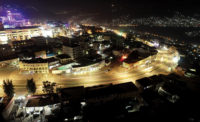The World Bank estimates that only one-third of the population in sub Saharan Africa living in rural areas is “within two kilometers of an all-season road, compared with two-thirds of the population in other developing regions.”
A handful of projects in the region are aimed at improving matters. Major road construction projects are underway alongside railway and port initiatives as the continent moves to create a seamless multimodal transport network.
Many of the the road projects are sponsored by eight regional economic communities on the continent through a mixture of public private partnerships models. Under various stages of development, they have attracted international infrastructure development companies and financiers.
Work features new road construction as well as rehabilitation in several areas. Key sections include: the 1033-kilometer Nacala Corridor that links Mozambique’s Nacala Port to Zambia’s capital Lusaka; East Africa’s 2000-km Northern Corridor linking Mombasa, Kenya, to landlocked South Sudan, Uganda, Rwanda, Burundi and eastern Democratic Republic of Congo; the 910-km Ethiopia-Djibouti Corridor and the Central Corridor in East Africa that connects Dar es Salaam to Burundi and Rwanda.
On the Nacala corridor, a four-phase road upgrading and construction project is ongoing. The project issued an invitation for bids in July for upgrading 75 km of Malawi’s Liwonde -Mangochi road using double bituminous surface as the preferred pavement structure under a 36-month contract. The work also includes spot improvement of 100 km of selected feeder roads.The new road will reduce travel costs by 40% and also cut travel time from two hours to 70 minutes.
The $267-million first phase of the Nacala road project, which is also ongoing, involves rehabilitation of the 348-km gravel Nampula-Cuamba road.
Chinese contractors China Henan International Cooperation Group and China Communications Construction and Portuguese construction company Construções Gabriel AS Couto hope to complete the project in the last quarter of the year. Financing has been provided by the AfDB, JICA and Korea Export-Import Bank.
The European Union and the European Investment Bank are financing phase two of the Nacala Corridor project, which will blacktop 162.8 km of the 360-km Luangwa-Mwami road. Portugal-based Mota-Engil and Condurji are the contractors of this phase split into four lots. Both the EU and EIB are providing $126 million (112 million euros) for the project.
The African Development Bank (AfDB), Japan International Cooperation Agency (JICA), Korea Export-Import Bank and Mozambique government are financing the $150-million third phase of the Nacala Corridor project. The job involves blacktopping the current 175-km gravel Muita-Mandimba-Lichinga road and building two roadside stations, one weighbridge and access roads.
Elsewhere, tendering is underway for a contractor to reconstruct the existing 208.6-km Chinsali-Nakonde carriageway on the North-South Corridor which links Angola, Namibia, Botswana, Zimbabwe, South Africa and Tanzania. The stretch is part of the 611.5-km Serenje-Nakonde road that is being reconstructed with partial financing from the AfDB. The Zambia Roads Authority says the road “has deteriorated and presents safety hazards to drivers due to its reduced width and deteriorated riding surface.” Denmark-based Grontmij A/S, in association with Bicon Zambia Ltd, prepared detailed engineering design for the tender documents.
In Central Africa, plans for the two-phase reconstruction of the 274-kilometre Ndende-Doussala-Dolissie earth road is at an advanced stage with AfDB having approved $141 million for the project likely to be completed in 2018. Additional financing will come from EU-Africa Infrastructure Trust Fund and the governments of Gabon and Congo. A contractor is yet to be picked for construction works. The road is part of the Tripoli-Windhoek Trans-Africa Highway and links the capitals of Libreville and Brazzaville. Work involves paving of 49 km Ndende-Doussala stretch in Gabon and 93-km Dolissie-Kibangou section in Congo with fiber optic cable on both sections.
An additional 130 km of earth road between Kibangou-Ngongo will be paved under phase two of the project. Another 103 km of feeder roads linked to this road in both countries will also be rehabilitated. The road will have 7m wide two-way pavement and a 1.5m wide shoulder on each side and fibre optic duct work.
In East African, construction is ongoing for the 245-km Arusha-Holili/Taveta-Voi road linking Kenya’s section of the Northern Corridor to the Tanzania side of the Central Corridor. The two corridors are among the five transport corridors in Eastern Africa.
In Kenya, China Overseas Construction Company Ltd is upgrading the 90-km Mwatate-Taveta stretch of the road. Upgrading of the 24.76-km Voi-Mwatate and 18-km Mwatate-Wundanyi sections has stalled after the contractor M/S Kundan Singh Construction Ltd, encountered financial setbacks in March, forcing Kenya to terminate the contract. The process has been launched for a new contractor. AfDB is providing a large share of the project financing while Kenya, Tanzania and the African Trade Fund are providing 5.9%, 4.7% and 0.3% of the total project costs.


Post a comment to this article
Report Abusive Comment